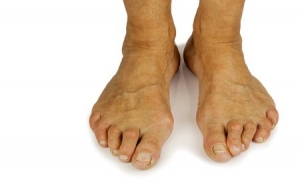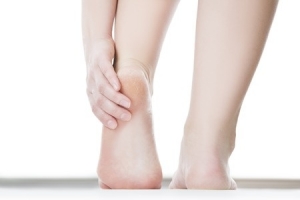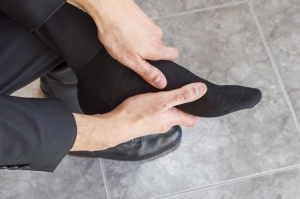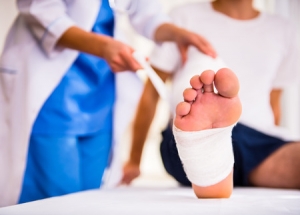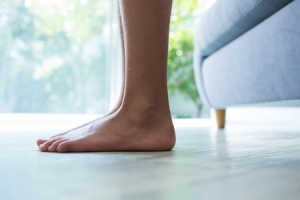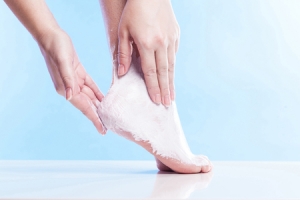Connect With Us
Blogs
Displaying items by tag: Flat Feet
Questions about Bunion Surgery
Bunions are a condition that we at Superior Foot & Ankle Care Center treat often. A bunion is a deformity of the toe joint that most often affects the big toe. It causes the joint to move out of place and drift toward the second toe. Bunions can have a number of different causes, including:
- Neuromuscular problems
- Flat feet
- Recurring stress to the foot
- Congenital defects
- Previous injury
- Arthritis
- Ill-fitting footwear
Bunions are a progressive disorder, which means they will continue to get worse over time. Our podiatrists, Dr. Victoria Foley or Dr. Constance Omelas will start by doing a complete physical examination of your feet. While conservative measures are always preferable, if your bunion has progressed to the point where it is impeding your ability to wear shoes and walk without pain, surgery may be the best treatment option. Below are some questions to ask before scheduling bunion surgery:
What type of bunion surgery do you recommend? There are several different kinds of bunionectomies. The foot and ankle surgeon will choose the type that best addresses the structural changes that have occurred to your toe because of the deformity. Ask the podiatrist to thoroughly explain the surgical procedure and ask questions if there is anything you don’t understand.
Where will the surgery take place? Bunion surgery is usually performed on an outpatient basis under local anesthesia. It will be necessary to have someone drive you home so be sure to arrange for that before the date of the surgery.
What will the recovery be like? You will have to avoid bearing weight on the affected foot for some period of time after the surgery. Ask the foot doctor how long you will need to be out of work. In addition, you’ll want to know how much discomfort to expect post operatively. Even after you are able to bear weight and return to work, you may need to do physical therapy or use a custom orthotic. Find out what results the podiatrist expects from the surgery and what the post-surgical treatment plan will consist of.
Knowing what to expect for your bunion surgery will reduce worry and help you better prepare for the modifications to your schedule. If you have additional questions, don’t hesitate to contact our Long Beach office by calling: (562) 420-9800.
5 Causes of Heel Pain
When your heel hurts, we at Superior Foot & Ankle Center know how limiting that can be on your day to day life. When every step is painful it’s difficult to walk, let alone work, shop, take care of children and household tasks or do any of the many other activities we normally take for granted. While resting your foot may temporarily ease heel soreness, permanent relief requires discovery of the source of the pain and developing a treatment plan that will address the root cause. Below are some common reasons for heel pain:
- Plantar fasciitis/heel spurs—this disorder is one of the most frequent reasons why patients experience heel pain. It occurs when the plantar fascia—a long band of tissue that stretches from your toes to your heel on the bottom of your foot—becomes injured or inflamed. If a patient is prone to plantar fasciitis they also have a greater likelihood of developing heel spurs, which are calcium deposits that build up in the heel and cause additional pain.
- The Wrong Shoes—sometimes eliminating heel pain is as simple as changing your shoes. Shoes that don’t provide adequate arch support or that position your foot in an abnormal way can inadvertently put extra pressure on your heel.
- Arch Issues—having flat feet or high arches alters the correct alignment of your feet with heel pain as a possible result.
- Calluses—these patches of hard, dry skin that appear on the surface of your heel are actually a sign of an internal irritation. The excessive pressure put on the heel by wearing high heels, being overweight, an altered gait or even the loss of the natural fat padding on your heel can all cause heel irritation which reveals itself in the callus.
- Nerve Problems—with disorders such as tarsal tunnel syndrome or Baxter neuropathy a compressed nerve in the foot or ankle can produce excruciating pain in the heel. If the pain is felt in both heels there is also a chance that the nerve issue is further up in the body in the spinal column.
Our podiatrists, Dr. Victoria Foley and Dr. Constance Ornelas will need to do a complete examination of your foot, ankle, and heel to diagnose the source of your heel pain. X-rays and other imaging studies may also be ordered. Once a diagnosis is confirmed, the foot doctor will be able to prescribe the correct treatment plan to resolve your heel pain. If you are experiencing pain in your heel, contact our Long Beach office by calling (562) 420-9800 today.
Could You Have Tarsal Tunnel Syndrome?
Do you experience a burning or tingling sensation that feels something like an electrical shock on the inside of your ankle bone? What about numbness or shooting pain in that area? If yes, you may be experiencing the symptoms of a condition known as Tarsal Tunnel Syndrome. At Superior Foot & Ankle Care Center we find that these symptoms can manifest in a number of ways. In some patients, they come on suddenly after a particularly strenuous workout session or after a long day of standing. The symptoms may also be experienced just in one spot or extend to the heel, calf, arch, and toes. This can make diagnosis a bit tricky because the symptoms are similar to those of several other podiatric conditions. Our podiatrists, Dr. Victoria Foley and Dr. Constance Ornelas will want to do a complete examination of your foot and ankle, checking for loss of sensation and trying to reproduce the symptoms you experience. Nerve conduction studies and advanced imaging studies may also be ordered.
Tracking Down the Source
The tarsal tunnel is literally a tunnel on the inside of your ankle that houses the posterior tibial nerve along with arteries, veins, and tendons. The tunnel is covered with a thick, protective ligament. Whenever something occurs that causes the nerve to be compressed the above symptoms can result. There are many different reasons for nerve compression:
- Flat feet—fallen arches cause the heel to turn outward which can put a strain on the posterior tibial nerve.
- Crowding—if an abnormal structure such as a ganglion cyst or a bone spur develops in the tunnel or a structure such as a tendon or varicose vein becomes enlarged it takes up more space in the tarsal tunnel, decreasing the amount of room for the nerves and other structures that belong in the tunnel. This causes the nerve to be squeezed or compressed.
- Injury—if you sprain your ankle or sustain another injury to that part of your foot the nerve may be compressed due to swelling or inflammation that occurs from the injury.
- Disease—certain diseases, such as diabetes and arthritis, also have swelling associated with them and will produce compression.
Once the foot doctor confirms a diagnosis of tarsal tunnel syndrome and determines the source the appropriate treatment can be prescribed. Left untreated the nerve damage can become permanent. So don’t delay—if you have symptoms, contact our Long Beach office at 562-420-9800.
3 Ways that Food Affects Your Feet
At Superior Foot & Ankle Care Center we know that the condition of your feet isn’t just about what goes on below your knees. Our podiatrists, Dr. Victoria M. Foley and Dr. Constance Ornelas believe that the health of the rest of your body plays a significant role in podiatric concerns. In honor of National Nutrition Month, we want to highlight the importance of proper eating and how it relates to your feet. Below are 3 ways that your diet can improve the health of your ankles and feet.
- Avoid Diabetes—diabetes, which afflicts over 30 million people in the U.S., affects your body’s ability to properly use or produce insulin resulting in high blood sugar levels. Diabetes reduces circulation and can cause neuropathy (loss of sensation) leaving your feet vulnerable to wounds and ulcers that can lead to infections and even possible amputation. The good news is you can prevent or significantly delay the onset of the most common form of this disease, Type 2 diabetes, with physical activity and modifications to your diet, including:
- Cutting way back on foods high in added sugar such as sodas and refined, processed foods
- Increasing the number of fruits, vegetables and whole-grain foods you consume every day
- Switching to healthier sources of fat such as olive and canola oil, nuts and avocados and avoiding saturated fats
- Prevent Gout Attacks and Inflammation—for patients who suffer from gout food is often what triggers an attack. Avoiding shellfish, red meat, beer, red wine, organ meats and heavy sauces can help you steer clear of this extremely painful joint inflammation which often happens in the big toe or ankle. Inflammation in, general, can be reduced by eating more berries, fish, and nuts high in omega 3 fatty acids, green vegetables, and olive oil, while steering clear of white sugar, fried food and refined flours.
- Decrease Your Risk of Foot Disorders—what do arthritis, plantar fasciitis, stress fractures and flat feet all have in common? The risk of developing one of these podiatric disorders as well as the severity of their symptoms are all increased by being overweight. There are many strategies for reducing and maintaining a healthy weight:
- Using smaller plates to automatically reduce portions
- Consulting a nutritionist or registered dietician to develop a healthy food plan
- Eat smaller portions more frequently instead of big meals
If you have questions about how changing your diet could impact a chronic foot condition contact our Long Beach office at 562-420-9800.
Post Op Pointers for Speedy Healing
At Superior Foot & Ankle Care Center we are committed to helping patients obtain relief from foot and ankle disorders using the least invasive methods possible. Sometimes, however, when conservative methods fail to give good results or a condition has progressed to a certain point, surgery is the best treatment option. Whether your surgery is to correct a bunion or help with flat feet, plantar fasciitis or another podiatric condition, what happens after the surgery is critical to completing the healing process. Below are some areas you should focus on if you are planning or have recently had podiatric surgery:
Plan Ahead—our feet are so crucial to daily living and yet we often take them for granted. If you will be unable to walk, even for a short period of time, you will need to put certain things into place prior to surgery:
- See that the area where you will be recovering has everything in easy reach—T.V. remote, books, water, phone, etc. If you sleep upstairs, you may need to set up a temporary bedroom on your main floor.
- Accept all offers of help for meals, running errands or caring for children.
- Clear your calendar of work and other appointments and obligations. Regardless of mobility, you will need rest immediately after surgery.
Wound Care—one of the most critical aspects of surgical recovery is preventing an infection from developing. Be sure you understand and follow all your foot doctor’s instructions for keeping surgical wounds clean. If you notice any signs of infection—warmth at the site of the surgery, redness or red streaks around the wound or fever—contact our podiatrists, Dr. Victoria Foley or Dr. Constance Omelas, immediately, even if it is after regular office hours.
Follow Through—don’t be your own foot doctor! Follow all of the podiatrist’s guidelines for your recovery and complete the full course of any physical therapy that is prescribed. Too often patients will discontinue therapy when they are feeling pain-free, but particularly for foot and ankle injuries strengthening of surrounding muscles and ligaments is necessary for full recovery. If you have any questions concerning post-operative care instructions or symptoms you experience after surgery don’t hesitate to contact our Long Beach office by calling: 562-420-9800.
What’s Behind Hallux Rigidus
Hallux rigidus is a form of degenerative arthritis that affects the big toe and one that we at Superior Foot & Ankle Care Center would rather treat in its earlier stages rather than its later ones. What starts out as stiffness in the toe joint will eventually progress to pain, decreased the range of motion and even a frozen big toe joint as the cartilage continues to deteriorate. Being unable to bend your big toe affects all motions that involve pushing off with the toe. These include essential activities like walking, running, squatting down and climbing stairs. At some point even standing and putting any weight on the toe at all can be extremely painful. In addition, hallux rigidus can lead to the development of other conditions such as bunions, bone spurs and calluses.
Who’s at Risk?
There are a number of factors that can increase your risk of developing hallux rigidus and not all of them are within your control. Structural abnormalities and faulty foot mechanics are often to blame for this disorder and those can be inherited or the result of another condition like flat feet or excessive pronation of the ankles which can cause stress to the toe joint. Hallux rigidus, like other forms of arthritis, may develop in a joint that was previously injured. It can also be the result of overuse of a sport that requires pushing off with the toe or a job where you are frequently squatting or doing other activities that bend the toe.
What Can be Done?
If after assessing the state of your big toe joint through examination and x-rays our podiatrists, Dr. Victoria Foley and Dr. Constance Ornelas diagnose hallux rigidus (or hallux limitus—the same condition at an earlier stage) the next step will be determining the correct treatment plan for you.
The foot doctor may recommend rest, icing and over the counter anti-inflammatory medications such as ibuprofen to bring relief of symptoms. Cortisone injections, changes in shoe choice, custom orthotics and physical therapies are all options that can help increase the range of motion and slow the progression of arthritis. In cases that are too far progressed or where there are additional complications, surgery may be the best option,
To learn more, contact our Long Beach office by calling: 562-420-9800.
Dealing with Flat Feet
A condition that we see frequently at Superior Foot & Ankle Care Center is flat feet. True to its name, “flat feet “describe a deformity in the foot where the arch of the foot is virtually nonexistent when a patient is standing. Although for many patients flat feet are not initially painful, they can lead to pain in the ankle, lower leg or middle of the foot. Having flat feet also makes you more susceptible to some other foot conditions such as plantar fasciitis. In addition to pain, flat feet can cause swelling and a lack of flexibility in the foot.
Who Gets Flat Feet?
There are several possible causes of flat feet. For some patients, the arch of the foot fails to develop properly during childhood. In other cases, it is something that occurs over time as the result of risk factors such as:
- Heredity
- Trauma or injury
- Aging
- Weight gain or pregnancy
- Arthritis
What Can be Done?
The course of treatment for flat feet will depend on the severity of the symptoms. Whether you have pain or not, if you notice that your feet seem to be flat and the floor without a normal arch you should contact our Long Beach office so that our podiatrists, Dr. Victoria Foley and Dr. Constance Omelas can examine your feet. Due to the possible genetic component of the condition, the foot doctor will want to get a family medical history as well. At the very least, the podiatrist will want to monitor your flat feet to ensure that a progressive disability does not develop over time. If you do have stiffness or pain the foot doctor may suggest any or all of the following:
- Stretching
- Physical therapy
- Icing
- Using arch supports or foot braces
If conservative measures don’t work or the arch issue is severe, reconstructive surgery may be an option.
If you have questions about flat feet or want to make an appointment to have your arches evaluated call us at 562-420-9800. We offer appointments before and after work and our helpful staff will work with you to find a time that works best with your busy schedule.
Give Your Feet a Gift this Holiday
Tis’ the season for shopping, baking, mailing and attending festive gatherings. And who is it that enables you to enjoy all the merry making of the holiday season? It’s your feet! At Superior Foot & Ankle Care Center we’d like to suggest some great gift ideas for those two very helpful parts of your body.
Moisture Wicking Socks—if you’re a sports enthusiast or just someone who’s on the go all the time these socks will whisk perspiration away from your feet. They can also be the inner layer of a double pair of socks if a ski vacation or other colder climate trip is part of your holiday plans. Keeping feet dry helps them stay warm and can prevent fungal infections (which love moist, dark places) from developing.
Insulated Water Bottle—you may not see the immediate connection to your feet on this one but drinking plenty of water is one way to prevent edema or swelling of your lower legs, ankles and feet. This means less pain at the end of a long day.
New Pair of Walking or Running Shoes—treat your feet to top quality exercise shoes. Have your foot professionally measured at a store that specializes in fitness footwear. Be sure to tell the shoe salesman about any conditions you have such as plantar fasciitis, flat feet or overpronation. Shoes that fit properly and accommodate any deformities or existing conditions will make exercising much more pleasurable and less likely to cause an injury. An added bonus: if you’re motivated to exercise you’ll have an easier time maintaining a healthy weight—a positive factor in preventing several foot disorders.
Super Emollient Foot Cream—nothing says “thanks” like a foot massage at the end of the day with a rich lotion or cream. Feet will stay moist and supple and unlikely to develop cracks or red, flaky patches.
Podiatric Checkup—if you’ve been putting off a visit to the foot doctor to find the source of a nagging pain, stiffness or something unusual that you’ve noticed on one of your feet this may be the best gift of all. Our podiatrists, Dr. Victoria Foley and Dr. Constance Omelas will not only diagnose any discomfort you’ve been experiencing, they can also help make recommendations for shoes that will best suit your individual foot and the activities you do. To make an appointment, contact our Long Beach office at: 562-420-9800.
Show Your Feet Some Lovin’ With Shoes That Fit
Did you know that August 17th is National I Love My Feet Day? At Superior Foot & Ankle Center we can think of no better way to tell your feet you care then by buying shoes that fit properly and are good for your feet. Many common foot problems can be avoided by wearing the correct shoes for your feet. Here are some tips on shoe shopping:
- Buy shoes based on quality of construction and materials that are designed for the health of your feet not on fads and appearance.
- Be sure any shoes you choose take current foot problems you have into consideration. At your next checkup with our podiatrists, Dr. Victoria Foley and Dr. Constance Omelas, ask if there are special features you should look for or avoid when buying shoes. In many cases, such as with bunions, hammertoes, flat feet or high arches, the foot doctor can make recommendations about shoe design that will decrease discomfort and help prevent a foot condition from getting worse. In some cases, a custom orthotic device may help shift pressure away from an area that hurts. If the podiatrist prescribes an orthotic be sure to bring it with you to try on with the shoes you are considering buying.
- Get your feet professionally measured. Feet can change size as you age. It’s not uncommon to find that one of your feet is larger than the other. You should always buy shoes to fit the bigger foot. Also, don’t assume once you know your size that you all brands will fit the same. Always try on shoes before purchasing.
- Heel heights of 1 inch or less are best. The higher the heel, the more pressure that is exerted on the forefoot. Avoid pointy shoes and those with narrow toe boxes.
- Shop for shoes at the end of the day. That’s when your feet are their largest and most swollen.
- Run your hand around the inside of both shoes to be sure there is no loose stitching or rough spots that might rub on your skin.
- Don’t rush! Try on both shoes and take some time to walk around the store to make sure that shoes fit well and are comfortable from the moment you leave the store.
If you have questions about other foot health care issues contact our Long Beach office by calling: 562-420-9800.
What to Bring on Summer Vacation—for Your Feet
If you’re packing for a summer trip, your feet may not be the first thing on your mind, but at Superior Foot & Ankle Care Center we want to remind patients that if your feet are hurting on vacation, you won’t enjoy yourself. The good news is your feet won’t need their own bag, just a few small items that can have a big impact on comfort, health and safety of your feet. Here’s what to bring:
- Moleskin—it’s a good idea not to bring brand new shoes that you haven’t worn before on a vacation. Chances are you’ll be doing more walking than usual and when you’re away from your closet is not the ideal time to discover that the shoes you brought are uncomfortable. Sometimes, however, even previously comfortable shoes can start to rub if it’s especially hot and your feet are sweaty from the increased activity. Moleskin can save the day. Put a small piece on the part of your foot that is feeling irritated and it will hopefully help you get through the day without a blister. Of course, you should still change your shoes as soon as possible.
- Sunscreen—this is probably already in your travel bag, but make sure you remember to apply it to the tops and bottoms of your feet as frequently as you apply to the rest of your body. Don’t forget to reapply after swimming.
- Emery board and nail clippers—a rough nail can become torn and painful. Keep an emery board with you for filing and bring along your nail clippers too. Remember to clip toenails straight across to help prevent ingrown nails from forming.
- Extra socks—if your feet tend to sweat excessively or you know you’ll be in a warm place where you’ll be doing activities like hiking or sightseeing, change your socks as soon as you feel that your feet are damp. This will help prevent a case of athlete’s foot from becoming your vacation souvenir. Fungal and bacterial infections thrive in dark, damp places.
- Flip flops—use these around the pool or at the beach to prevent feet from coming in contact with fungi in public places. Don’t wear these as your everyday shoes however, or you risk injury and other painful foot conditions such as plantar fasciitis and flat feet.
If you do injure your foot while you are away be sure to seek treatment promptly and follow up by contacting our Long Beach, CA office for an appointment when you return. Our podiatrists, Dr. Victoria Foley and Dr. Constance Ornelas will want to check your foot and be sure that it is healing properly.
